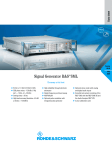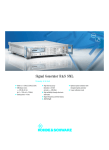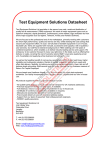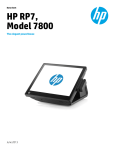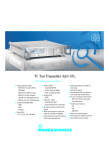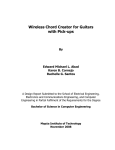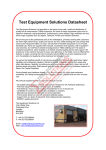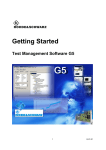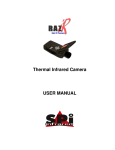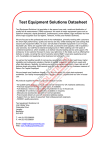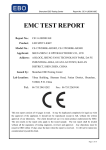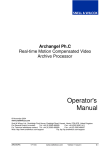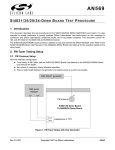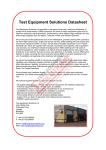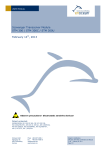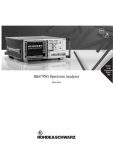Download ROHDE & SCHWARZ SML01 Datasheet
Transcript
Test Equipment Solutions Datasheet Test Equipment Solutions Ltd specialise in the second user sale, rental and distribution of quality test & measurement (T&M) equipment. We stock all major equipment types such as spectrum analyzers, signal generators, oscilloscopes, power meters, logic analysers etc from all the major suppliers such as Agilent, Tektronix, Anritsu and Rohde & Schwarz. We are focused at the professional end of the marketplace, primarily working with customers for whom high performance, quality and service are key, whilst realising the cost savings that second user equipment offers. As such, we fully test & refurbish equipment in our in-house, traceable Lab. Items are supplied with manuals, accessories and typically a full no-quibble 2 year warranty. Our staff have extensive backgrounds in T&M, totalling over 150 years of combined experience, which enables us to deliver industry-leading service and support. We endeavour to be customer focused in every way right down to the detail, such as offering free delivery on sales, covering the cost of warranty returns BOTH ways (plus supplying a loan unit, if available) and supplying a free business tool with every order. As well as the headline benefit of cost saving, second user offers shorter lead times, higher reliability and multivendor solutions. Rental, of course, is ideal for shorter term needs and offers fast delivery, flexibility, try-before-you-buy, zero capital expenditure, lower risk and off balance sheet accounting. Both second user and rental improve the key business measure of Return On Capital Employed. We are based near Heathrow Airport in the UK from where we supply test equipment worldwide. Our facility incorporates Sales, Support, Admin, Logistics and our own in-house Lab. All products supplied by Test Equipment Solutions include: - No-quibble parts & labour warranty (we provide transport for UK mainland addresses). - Free loan equipment during warranty repair, if available. - Full electrical, mechanical and safety refurbishment in our in-house Lab. - Certificate of Conformance (calibration available on request). - Manuals and accessories required for normal operation. - Free insured delivery to your UK mainland address (sales). - Support from our team of seasoned Test & Measurement engineers. - ISO9001 quality assurance. Test equipment Solutions Ltd Unit 8 Elder Way Waterside Drive Langley Berkshire SL3 6EP T: +44 (0)1753 596000 F: +44 (0)1753 596001 Email: [email protected] Web: www.TestEquipmentHQ.com Data sheet Version 06.00 August 2004 Signal Generator ¸SML Economy at its best ◆ 9 kHz to 1.1 GHz/2.2 GHz/3.3 GHz ◆ SSB phase noise: −128 dBc (1 Hz) (at f = 1 GHz, ∆f = 20 kHz) ◆ Setting times <10 ms ◆ High level accuracy (deviation <0.5 dB at levels >−120 dBm) ◆ High reliability through electronic attenuator ◆ Digital frequency and level sweep ◆ AM/FM/ϕM ◆ Optional pulse modulator with integrated pulse generator ◆ Optional stereo coder with analog and digital audio inputs ◆ Versatile test system consisting of the ¸SML with the ¸SML-B5 and the Audio Analyzer ¸UPL ◆ 3-year calibration cycle Unequalled universality Frequency Spectral purity Low cost of ownership ◆ 9 kHz to 1.1 GHz/2.2 GHz/3.3 GHz ◆ 0.1 Hz frequency resolution ◆ SSB phase noise <−122 dBc (1 Hz), typ. −128 dBc (1 Hz) (f = 1 GHz, carrier offset 20 kHz) ◆ Broadband noise <−140 dBc (1 Hz), typ. −150 dBc (1 Hz) (f = 1 GHz, carrier offset >2 MHz) ◆ 3-year calibration cycle ◆ Low purchase price ◆ High reliability through electronic attenuator (wear-free) ◆ Service-friendly (continuous selftest, access to internal test points) ◆ Options OCXO (¸SML-B1), pulse modulator (¸SML-B3) and Stereo/RDS Coder (¸SML-B5) retrofittable Level ◆ −140 dBm to +13 dBm (+19 dBm overrange) ◆ High level accuracy (deviation <0.5 dB at levels >−120 dBm) ◆ Level setting without overshoots ◆ Electronic attenuator ◆ Non-interrupting level setting Speed ◆ Setting times <10 ms for frequency and level Size Modulation ◆ AM/FM/ϕM as standard ◆ Simultaneous AM, FM/ϕM and pulse modulation ◆ Optional pulse modulator with integrated pulse generator (¸SML-B3) 2 Signal Generator ¸SML ◆ Compact size: 427 mm × 88 mm × 450 mm ◆ Low weight: <8.5 kg Applications ... Lab and R&D: versatile Example: receiver measurements High spectral purity Owing to its low phase noise, the ¸SML is ideally suited to replace LOs. ◆ Sensitivity measurements require a signal generator with high level accuracy. This is particularly true at low output levels. With its sophisticated calibration technique, the ¸SML features high level accuracy (<0.5 dB at levels >−120 dBm). ◆ Squelch measurements call for continuous level setting. Non-interrupting level variation by typ. 30 dB makes the ¸SML the ideal choice for squelch measurements. ◆ Low spurious, low broadband noise and above all excellent SSB phase noise are prerequisites for using a signal generator as an interference source. With typ. −128 dBc (1 Hz) SSB phase noise (at f = 1 GHz, ∆f = 20 kHz), spurious suppression of typ. −76 dBc and broadband noise of typ. −150 dBc (1 Hz), the ¸SML easily meets even the most exacting requirements. Versatile modulation modes The ¸SML in conjunction with the optional Pulse Modulator ¸SML-B3 handles all analog types of modulation. AM, FM/ϕM and pulse modulation can be used simultaneously. TDMA signals or amplitude variations in the case of FM, for example, can thus be simulated. High and precise output level The ¸SML has plenty of power in reserve so level loss produced by the test setup can be easily compensated. Its high output level makes the ¸SML an ideal source for driving high-level mixers. Excellent modulation characteristics The DC-coupled FM allows the ¸SML to be used as an accurate VCO. The ¸SML offers all features required of a state-of-the-art general-purpose signal generator: wide frequency range, large variety of modulation functions and high reliability – at an extremely attractive price. The fields of application of the ¸SML are virtually unlimited in development, servicing or production where it is used as a flexible signal source in automatic test systems. The ¸SML benefits both from our long-standing experience in the field of signal generators and the latest technology. Its uses are as versatile as its functionalities. ◆ The mechanical design of the ¸SML ensures excellent RF shielding of its casing. This is particularly important for measurements on highly sensitive receivers with built-in antenna such as pagers. +100 Hz 1 GHz Frequency deviation in Hz –100 Hz rise time 1 2 3 4 5 6 7 8 9 10 Time in ms Level sweep within 25 dB range. Settling upon frequency change from 100 MHz to 1 GHz. Signal Generator ¸SML 3 Servicing: robust, compact, lightweight Mobility The ¸SML is lightweight and compact and therefore very easy to transport. Flexible control In service environments, an IEC/IEEE interface is not always available for controlling the generator. This is no problem for the ¸SML since it can also be driven via a standard RS-232-C interface. Protection against overvoltage The integrated overvoltage protection of the RF input protects the ¸SML against very high external voltages such as may occur during transceiver measurements. Production: fast, accurate, reliable Accuracy Measurement uncertainty can be split into the part from the instrument and that introduced by the test setup. With lower uncertainty of the generator, greater tolerances can be allowed for the setup. If the low level deviation of the analyzer is used to allow for higher DUT tolerances, Example: component test the result will be a marked reduction in manufacturing rejects – an advantage that pays off immediately. ◆ To obtain reliable information on component quality, high level accuracy and precise reproducibility of the output level are called for. The ¸SML fully meets these requirements owing to the level deviation of <0.5 dB (at levels >−120 dBm) and high reproducibility. ◆ With unrivalled short times (<10 ms) for frequency and level setting, the ¸SML enables fast testing and is ideal for use in production. ◆ Overshoots in case of level change may damage or destroy the DUT. This cannot happen with the ¸SML since it operates without any overshoots. Speed Speed is of prime importance in production. And this is precisely one of the strong points of the ¸SML, with a setting time of <10 ms for frequency and level. Reliability A signal generator used in production must have high reliability. The ¸SML meets this requirement for example through the use of a completely wearfree electronic attenuator. Should a fault nevertheless occur, the continuous selfdiagnostics of the ¸SML prevent expensive erroneous measurements. Output level In production test systems, the signal is taken to the DUT (device under test) via switches and cables, thus leading to level losses. These losses can be easily compensated by the high output power of the ¸SML. EMS measurements Non-interrupting level setting without overshoots EMS measurements call for noninterrupting level setting, which should moreover be performed without any overshoots. The ¸SML operates free of overshoots and offers a wide dynamic range of typ. 30 dB for non-interrupting level variation (with Attenuator Mode Fixed). Dimensions Space is often at a premium in production. The compact size of the ¸SML makes it ideal for use in such environments. –115 Phase noise in dBc (1 Hz) –120 –125 –130 –135 –140 –145 –150 10 50 100 500 1000 3300 Frequency in MHz Typical SSB noise at 1 GHz (with OCXO option ¸SML-B1). 4 Signal Generator ¸SML Typical SSB phase noise versus carrier frequency (carrier offset 20 kHz); dashed line: Extended Divider Range mode. Wide frequency range The ¸SML has a lower frequency limit of 9 kHz as standard and thus fully covers the frequency range required for EMC measurements. SSB phase noise at 9.5 MHz output frequency, extended divider range activated, 1 Hz measurement bandwidth. Offset from carrier SSB phase noise, typical values 1 Hz –95 dB 10 Hz –120 dB 100 Hz –130 dB 1 kHz –138 dB 10 kHz –148 dB Reference source The ¸SML allows the mode of frequency generation to be selected. In the Extended Divider Range mode, the RF signal is generated by frequency division. The excellent values obtained in this mode for SSB phase noise are comparable with the high-grade crystal oscillators normally used as reference sources from 10 MHz to 30 MHz. Compared to crystal oscillators, the ¸SML provides the following benefits: ◆ Frequency can be set in 0.1 Hz steps and synchronized to an external reference ◆ All functions can be remotely controlled via the IEC/IEEE bus or serial interface Signal Generator ¸SML+Stereo/RDS Coder ¸SML-B5 RF-modulated test signal including ARI and RDS FM stereo tuner Audio signals produced by the built-in LF generator of the ¸SML. Generation of stereo and RDS signals FM stereo broadcasting is still the major audio medium – especially in the automobile sector, where millions of car radios are produced every year. With its integration into mobile radio telephones, FM broadcasting becomes even more significant. For testing FM stereo receivers, audio test signals are modulated onto an RF carrier and measured after demodulation by the DUT. For the car radio sector, automotive radio information (ARI) has to be generated in addition. Test signals are also needed for the radio data system (RDS), which has been established in many countries for a long time. Stereo/RDS Coder ¸SML-B5 The optional Stereo/RDS Coder ¸SML-B5 meets all the above requirements. Built into instruments of the Signal Generator Family ¸SML, the solution is based on equipment featuring an excellent price/performance ratio as well as top-class specifications and providing full coverage of the frequency range in question. Audio signals produced by internal LF generator The internal LF generator, which is suitable for simple receiver tests, is part of the basic configuration of the ¸SML. It generates sinusoidal signals at fixed frequencies, thus allowing basic functional tests to be carried out without an external signal (see figure on left). Combination with the Audio Analyzer ¸UPL The stereo/RDS coder can also work with external signals applied to its analog and digital modulation inputs. Combining the Signal Generator ¸SML and the Audio Analyzer ¸UPL (data sheet PD 0757.2238) creates a general-purpose test system for FM tuners (see figure on next page). The great advantage is the automatic synchronization of measurement results. Just as in other two-port audio measurements, the test signals are produced in the generator section of the Audio Analyzer ¸UPL, routed through the modulator and the DUT, and measured in the analyzer section of the ¸UPL. Since generation and analysis are optimally timed, measurement times are considerably shorter than with separately operating instruments. Use in production Combining the Signal Generator ¸SML and the Audio Analyzer ¸UPL enables measurements to be automated. The Universal Sequence Control ¸UPL-B10 allows complete test programs to be generated and run on the ¸UPL, in which case the Signal Generator ¸SML with the ¸SML-B5 option is remote-controlled via the IEC60625 or RS-232-C interface. In most production environments, the complete test set can be run under an external controller. Signal Generator ¸SML 5 Analog and digital audio inputs The ¸SML-B5 has separate analog inputs for left and right. In combination with the Audio Analyzer ¸UPL, measurements are possible in the operating modes L, R, R = L, and R = –L. A digital audio input in S/P DIF format is available alternatively. The ¸UPL can additionally generate different signals for left and right in this format. It is possible to set one channel to a fixed frequency while sweeping the second channel through a frequency band, for example. Signal Generator ¸SML+Stereo/RDS Coder ¸SML-B5 RF-modulated test signal including ARI and RDS Analog or digital audio signals FM stereo tuner Signal generation and analysis with Audio Analyzer ¸UPL Analog audio signals Audio signals are generated and measured in the Audio Analyzer ¸UPL; automatic synchronization substantially reduces the measurement time. All functions of the Stereo/RDS Coder ¸SML-B5 can of course be remotecontrolled. Use of the Audio Switcher ¸UPZ is recommended for measurements on car radios or surround receivers with more than two audio outputs, as shown in the figure on the right. For more information about the Audio Switcher ¸UPZ, see data sheet PD 0758.1170. Interruption-free pilot tone The ¸SML-B5 option was designed especially for use in test systems. With other signal generators, the stereo pilot tone is briefly interrupted if the output data has to be recalculated (e.g. when the audio frequency changes). The connected tuner loses synchronization and has to switch to the stereo mode again with each frequency change, so overall measurement time may increase dramatically. This disadvantage does not occur with the ¸SML-B5 since the audio signal is modulated onto the RF carrier independently of pilot tone generation, and consequently the pilot tone is not switched off. 6 Signal Generator ¸SML Generation of ARI and RDS signals The ¸SML-B5 outputs stereo multiplex as well as ARI and RDS signals. It is possible to choose between traffic announcement identification and standardized area identification A to F. The RDS traffic program or RDS traffic announcement can be switched on and Signal Generator ¸SML+Stereo/RDS Coder ¸SML-B5 RF-modulated test signal including ARI and RDS Analog or digital audio signals FM stereo tuner Audio Switcher ¸UPZ Signal generation and analysis with Audio Analyzer ¸UPL Analog audio signals The Audio Switcher ¸UPZ for automated measurements on more than two audio outputs. Signal output by the stereo/RDS coder prior to FM modulation with ARI and RDS information. off. Up to five different RDS sequences can be loaded. With a length of up to 64000 characters per sequence, future RDS applications (e.g. radio text) can also be tested. Turn EasyWheel Click ◆ One-hand operation with EasyWheel ◆ All settings simple and self-explanatory ◆ High-contrast LCD ◆ User-assignable menu keys ◆ Online help including IEC/IEEE-bus commands Simply select the desired menu with the spinwheel and click the button to open the submenu. Certified Quality System Certified Environmental System ISO 9001 ISO 14001 DQS REG. NO 1954 QM DQS REG. NO 1954 UM Signal Generator ¸SML 7 Specifications Specifications apply under the following conditions: 15 minutes warmup time at ambient temperature, specified environmental conditions met, calibration cycle adhered to, and total calibration performed. Data designated “nominal” apply to design parameters and are not tested. Data designated “overrange” are not warranted. Warranted specs do not apply to the Extended Divider Range mode. Frequency Range 9 kHz to 1.1 GHz ¸SML01 ¸SML02 ¸SML03 9 kHz to 1.1 GHz 9 kHz to 2.2 GHz 9 kHz to 3.3 GHz Resolution 0.1 Hz Resolution of synthesis (standard, f <1.1 GHz) <0.5 µHz Characteristic impedance VSWR ¸SML01 ¸SML02/03 100 kHz to 1.5 GHz f >1.5 GHz Non-interrupting level setting (for f >100 kHz)5) Overvoltage protection Reference frequency Standard Option ¸SML-B1 Aging (after 30 days of operation) <1 × 10−6/year <1 × 10−7/year or <5 × 10−10/day Temperature drift (0°C to 55°C) <1 × 10−6 Output for internal reference Frequency Output voltage, V rms, sinewave Source impedance 10 MHz >0.5 V into 50 Ω 50 Ω <2 × 10−8 10 MHz 5 × 10–6 0.5 V to 2 V into 50 Ω 50 Ω <0.7 dB <1.0 dB 50 Ω <1.5 typ. 1.6 typ. 2.3 20 dB, overrange 30 dB safeguards unit against externally applied RF power and DC voltage (50 Ω source) Max. permissible RF power f ≤2.2 GHz f >2.2 GHz 50 W 25 W Max. permissible DC voltage 35 V Internal modulation generator Frequency range Resolution 0.01 Hz to 1 MHz 0.01 Hz Frequency accuracy same as for reference frequency + 2.4 × 10−3 Hz Frequency response (up to 500 kHz, level >100 mV) <0.5 dB THD (up to 100 kHz, level 4 V, RL = 600 Ω) <0.1% Open-circuit voltage Vp (LF connector) 1 mV to 4 V Resolution 1 mV Setting accuracy (at 1 kHz) 1% of Vp + 1 mV Output impedance Spectral purity Spurious signals Harmonics (for f >100 kHz)1) ¸SML01 ¸SML02/03 Subharmonics f ≤1.1 GHz f >1.1 GHz Nonharmonics (carrier offset >10 kHz) f ≤1.1 GHz f >1.1 GHz to 2.2 GHz f >2.2 GHz to 3.3 GHz <0.5 dB, typ. 0.3 dB Setting time (IEC/IEEE bus), f >100 kHz <10 ms, typ. 5 ms Setting time (for an offset of <1 × 10−7 or <90 Hz for f ≤76 MHz) after IEC/IEEE-bus delimiter <10 ms Input for external reference Frequency Permissible frequency drift Input voltage, V rms, sinewave Input impedance Frequency response at 0 dBm2)4) ¸SML01 (for f >100 kHz) ¸SML02/03 100 kHz to ≤2 GHz f >2 GHz approx. 10 Ω Frequency setting time (after reception of last IEC/IEEE-bus character) <10 ms <−30 dBc at levels ≤+10 dBm <−30 dBc at levels ≤+8 dBm none <–50 dBc Simultaneous modulation Amplitude modulation6) Operating modes internal, external AC/DC, internal/external two-tone Modulation depth 0% to 100%, settable modulation depth continuously decreasing between +7 dBm and +13 dBm7) while adhering to AM specifications; a status message is output when modulation depth is too high Resolution 0.1% <4% of reading +1% <–70 dBc <–64 dBc <–58 dBc Broadband noise2) (f = 1 GHz, carrier offset >2 MHz, 1 Hz bandwidth) <−140 dBc, typ. −150 dBc AM, FM/ϕM and pulse modulation SSB phase noise (f = 1 GHz, 20 kHz carrier offset, 1 Hz bandwidth) <−122 dBc, typ. −128 dBc Residual FM, rms (f = 1 GHz) 0.3 kHz to 3 kHz 0.03 kHz to 20 kHz Setting accuracy at AF = 1 kHz (m <80%)8) <4 Hz, typ. 1 Hz <10 Hz, typ. 3 Hz AM distortion8) at AF = 1 kHz m = 30% m = 80% <1% <2% Modulation frequency range (<3 dB) DC/10 Hz to 50 kHz Incidental ϕM at AM (30%), AF = 1 kHz <0.2 rad Residual AM, rms (0.03 kHz to 20 kHz) <0.02% Level –140 dBm to +13 dBm2)3) (overrange +19 dBm) Range Resolution 0.1 dB 2)4) Level accuracy (level >–120 dBm) ¸SML01 (for f >100 kHz) ¸SML02/03 100 kHz to ≤2 GHz f >2 GHz Modulation input EXT Input impedance Input voltage Vp for set modulation depth >100 kΩ 1V <0.5 dB <0.5 dB <0.9 dB Signal Generator ¸SML 8 Frequency modulation Operating modes Pulse generator (with option ¸SML-B3) internal, external AC/DC, internal/external two-tone Operating modes Frequency deviation 9 kHz to 76 MHz >76 MHz to 151.3125 MHz >151.3125 MHz to 302.625 MHz >302.625 MHz to 605.25 MHz >605.25 MHz to 1.2105 GHz >1.2105 GHz to 1.818 GHz >1.818 GHz to 2.655 GHz >2.655 GHz to 3.300 GHz automatic, externally triggered, external gate mode, single pulse, double pulse, delayed pulse (externally triggered) 0 Hz to 1 MHz 0 Hz to 125 kHz 0 Hz to 250 kHz 0 Hz to 500 kHz 0 Hz to 1 MHz 0 Hz to 2 MHz 0 Hz to 3 MHz 0 Hz to 4 MHz Active trigger edge positive or negative Pulse period Resolution Accuracy 100 ns to 85 s 5 digits, min. 20 ns <1 × 10−4 Pulse width Resolution Accuracy 20 ns to 1 s 4 digits, min. 20 ns <(1 × 10−4 + 3 ns) Resolution <1% of set deviation, minimum 10 Hz Setting accuracy (at AF = 1 kHz) <4% of reading + 20 Hz Pulse delay Resolution Accuracy 20 ns to 1 s 4 digits, min. 20 ns <(1 × 10−4 + 3 ns) FM distortion (at AF = 1 kHz and 50% of max. deviation) <0.2%, typ. 0.1% Modulation frequency range (<3 dB), standard/wide Double-pulse spacing Resolution Accuracy 20 ns to 1 s 4 digits, min. 20 ns <(1 × 10−4 + 3 ns) DC/10 Hz to 100 kHz/500 kHz Trigger delay typ. 50 ns Jitter <10 ns PULSE/VIDEO output TTL signal (RL ≥50 Ω) Incidental AM (at AF = 1 kHz, f >10 MHz, 40 kHz deviation) <0.1% Stereo modulation at 40 kHz useful deviation, AF = 1 kHz, RF = 87 MHz to 108 MHz Crosstalk attenuation S/N ratio unweighted, rms S/N ratio weighted, rms Distortion (for external multiplex signal) Carrier frequency offset at FM DC typ. 0.1% of set deviation Modulation input EXT Input impedance Input voltage Vp for set deviation (nominal value) Stereo/RDS Coder (with option ¸SML-B5) >50 dB >70 dB >70 dB <0.2%, typ. 0.1% >100 kΩ 1V internal, external AC/DC, internal/external two-tone 9) Phase deviation 9 kHz to 76 MHz >76 MHz to 151.3125 MHz >151.3125 MHz to 302.625 MHz >302.625 MHz to 605.25 MHz >605.25 MHz to 1.2105 GHz >1.2105 GHz to 1.818 GHz >1.818 GHz to 2.655 GHz >2.655 GHz to 3.300 GHz 0 rad to 10 (2) rad 0 rad to 1.25 (0.25) rad 0 rad to 2.5 (0.5) rad 0 rad to 5 (1) rad 0 rad to 10 (2) rad 0 rad to 20 (4) rad 0 rad to 30 (6) rad 0 rad to 40 (8) rad Resolution <1%, min. 0.001 rad Setting accuracy at AF = 1 kHz <4% of reading + 0.02 rad Phase distortion (at AF = 1 kHz and 50% of maximum deviation) <0.2%, typ. 0.1% Modulation frequency range (–3 dB), standard/wide Modulation inputs EXT Input impedance Input voltage Vp for set deviation (nominal value) DC/10 Hz to 100 kHz/500 kHz >100 kΩ 1V Pulse modulation (with option ¸SML-B3) Operating modes internal, external On/off ratio >90 dB Rise/fall time (10%/90%) <20 ns, typ. 10 ns Pulse repetition frequency 0 Hz to 2.5 MHz Pulse delay typ. 50 ns Video crosstalk (Vp) <30 mV Modulation input PULSE Input level Input impedance Stereo modes Internal with modulation generator L, R, R = L, R = –L External analog (via L and R inputs) or external digital (via S/P DIF input) L, R, R = L, R = –L, R ≠ L internal generation of ARI/RDS signals, 5 user-selectable RDS data sets, simultaneous generation of MPX, ARI and RDS signals possible MPX frequency deviation Resolution Phase modulation Operating modes The specifications apply to RF frequencies in the range 66 MHz to 110 MHz. L, R signal AF frequency range AF frequency response (referenced to 500 Hz) AF = 20 Hz to 40 Hz AF = 40 Hz to 15 kHz 0 Hz to 80 kHz 10 Hz 20 Hz to 15 kHz <0.3 dB <0.2 dB Stereo crosstalk attenuation (at AF = 1 kHz) >50 dB Distortion (at 67.5 kHz MPX frequency deviation, AF = 1 kHz) <0.1%, typ. 0.05% S/N ratio10) (stereo/RDS signal) ITU-R weighted (quasi-peak) ITU-R unweighted (rms) A-weighted (rms) >60 dB, typ. 63 dB >70 dB, typ. 74 dB >70 dB, typ. 76 dB Preemphasis off, 50 µs, 75 µs Pilot tone Frequency Deviation Resolution Phase (relative to 38 kHz phase) Resolution 19 kHz ±2 Hz 0 Hz to 10 kHz 10 Hz 0° to ±5° 0.1° ARI/RDS subcarrier frequency 57 kHz ±6 Hz ARI frequency deviation Resolution 0 Hz to 10 kHz 10 Hz RDS frequency deviation Resolution 0 Hz to 10 kHz 10 Hz TTL level (HCT) 10 kΩ or 50 Ω, selectable with internal link Signal Generator ¸SML 9 ARI/RDS ARI identification ARI BK RDS traffic program RDS traffic announcement RDS data set Maximum data length functions (directly selectable by menu or remote control) selection of traffic announcement identification (DK) or area identification (BK), OFF, DK, BK, DK + BK selection of standardized area identification A to F traffic program off/on traffic announcement off/on selection of RDS data set 1 to 5 64 kByte, can be loaded via IEC60625 or RS-232-C interface Climatic resistance Damp heat 95% relative humidity at +25°C/+40°C cyclically; meets EN60068-2-30: 2000-02 Mechanical resistance Vibration, sinusoidal 5 Hz to 150 Hz, max. 2 g at 55 Hz, max. 0.5 g between 55 Hz and 150 Hz, meets EN60068-2-6: 1996-05, EN61010-1 and MIL-T-28800D, class 5 Vibration, random 10 Hz to 300 Hz, acceleration 1.2 g (rms) Shock 40 g shock spectrum, meets MIL-STD-810E and MIL-T-28800D, class 3/5 Analog modulation inputs L, R Input impedance Input voltage Vp for selected deviation (nominal value) 2 × BNC 600 Ω or 100 kΩ 1V Electromagnetic compatibility Digital modulation input S/P DIF Input impedance Input voltage Vpp BNC 75 Ω 1 V (400 mV to 5 V) Susceptibility to radiated interference 10 V/m Sweep digital in discrete steps RF sweep, AF sweep Operating modes automatic, single-shot, manually or externally triggered, linear or logarithmic user-selectable user-selectable 0.01% to 100% Sweep range Step width (lin) Step width (log) Level sweep Operating modes Power supply 100 V to 120 V (AC), 50 Hz to 400 Hz, 200 V to 240 V (AC), 50 Hz to 60 Hz, autoranging, max. 200 VA Safety meets EN61010-1, UL 3111-1, CSA 22.2 No. 1010-1 Dimensions (W × H × D) 427 mm × 88 mm × 450 mm Weight 8.5 kg when fully equipped 1) 2) Sweep range Step width (log) Step time Resolution automatic, single-shot, manually or externally triggered, logarithmic user-selectable user-selectable 3) 10 ms to 1 s 0.1 ms 7) 4) 5) 6) 8) 9) 10) Memory for device settings Storable settings meets EN61000-6-3 and EN61000-6-4 (EMC directive of EU) With option ¸SML-B3 only for f >20 MHz. With Attenuator Mode Auto. –140 dBm to +11 dBm at f ≤5 MHz, f >3 GHz for ¸SML02 and ¸SML03. Temperature range 20°C to 30°C. With Attenuator Mode Fixed. With Attenuator Mode Auto, f ≥100 kHz. +5 dBm to +11 dBm at f ≤5 MHz, f >3 GHz. With option ¸SML-B3 only for f >10 MHz. Values in brackets apply to wide modulation bandwidth. Generator without preemphasis, receiver with deemphasis. 100 Ordering information Remote control Signal Generator System IEC60625 (IEEE 488) and RS-232-C Command set SCPI 1995.0 Connector Amphenol, 24-pin and 9-pin Accessories supplied IEC/IEEE-bus address 0 to 30 Power cable, user manual Interface functions SH1, AH1, T6, L4, SR1, RL1, PP1, DC1, DT1, C0 Options Reference Oscillator OCXO Pulse Modulator Stereo/RDS Coder Rear Connectors for AF, RF Specs complied with between 0°C and 55°C; meets EN60068-2-1: 1995-03 and EN60068-2-2: 1994-08 Storage temperature range −40°C to +70°C Recommended extras Service Kit 19“ Rack Adapter Transport Bag Service Manual, Modules General data Temperature loading 1) ¸SML01 ¸SML02 ¸SML03 1090.3000.11 1090.3000.12 1090.3000.13 ¸SML-B1 ¸SML-B3 ¸SML-B5 ¸SML-B19 1090.5790.02 1090.5403.021) 1147.8805.021) 1090.5303.021) ¸SML-Z2 ¸ZZA-211 ¸ZZT-214 1090.5203.02 1096.3260.00 1109.5119.00 1090.3123.24 Factory-fitted only. www.rohde-schwarz.com R&S® is a registered trademark of Rohde&Schwarz GmbH&Co. KG · Trade names are trademarks of the owners PD 0758.1664.32 · ¸SML · Version 06.00 · August 2004 · Data without tolerance limits is not binding · Subject to change











